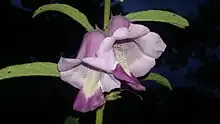Sesamum radiatum
Sesamum radiatum is a species of flowering plant in the Pedaliaceae. It is in the same genus as sesame, and is known by the English common names benniseed, black benniseed,[2] black sesame,[3] and vegetable sesame.[4] It is native to west and central Africa, has been cultivated since ancient times in Africa, and is sometimes also used in tropical Asia where it has become naturalized to a small extent.[2]
| Sesamum radiatum | |
|---|---|
 | |
| Benniseed flowers | |
| Scientific classification | |
| Kingdom: | Plantae |
| Clade: | Tracheophytes |
| Clade: | Angiosperms |
| Clade: | Eudicots |
| Clade: | Asterids |
| Order: | Lamiales |
| Family: | Pedaliaceae |
| Genus: | Sesamum |
| Species: | S. radiatum |
| Binomial name | |
| Sesamum radiatum | |
| Synonyms[1] | |
| |
Etymology
Benniseed is a portmanteau of both the word benne and seed. Benne, meaning sesame derives from Gullah benne which is akin to Malinke bĕne.[5][6][7]
Use
Culinary
The seeds are eaten whole, made into a paste, ground into a powder, or pressed for a high-quality oil.[2] The leaves can be eaten fresh or cooked and are used in Sub-Saharan Africa as a leaf vegetable.[2][4] The leaves are mucilaginous in texture when cooked. The shoots can also be eaten and are used in soups and porridge.[8]
Cultivation
This plant is an annual herb growing up to 1.2 to 1.5 metres (3 ft 11 in to 4 ft 11 in) tall. The leaves are opposite, or toward the top of the plant, alternately arranged. The leaves are lance-shaped to oval and up to 12 centimetres (5 in) long. They may be smooth-edged or serrated. Flowers occur singly in the leaf axils. They are pink to purple in color, sometimes white, and somewhat bell-shaped. They measure up to 5 centimetres (2 in) long. The fruit is a capsule up to 3.5 centimetres (1+3⁄8 in) long which contains seeds roughly 3 millimetres (15⁄128 in) long.[2]
This plant grows wild in savanna and other habitat types. It is also a weed of fields and homesteads. It can grow on poor, rocky soils and it flowers even through drought conditions. When cultivated the plant yields 5 to 6 metric tons (5.5 to 6.6 short tons) of leaves per hectare.[2]
This plant is vulnerable to the leaf spot disease Cercospora sesami. It is also attacked by hawk moths (Sphingidae), the moth Antigastra catalaunalis, and the vegetable bug Nezara viridula.[2]
References
- "The Plant List: A Working List of All Plant Species". Retrieved 14 January 2015.
- "Sesamum radiatum". PROTA. Archived from the original on 2018-03-01.
- Konan, A. B., et al. (2011). Myostimulating effect of Sesamum radiatum aqueous leaf extract in isolated guinea-pig taenia caeci contractile activity. Afr J Tradit Complement Altern Med. 8(4): 377–385.
- B.M. Auwalu and F.E. Babatunde. (2007). Analyses of growth, yield and fertilization of vegetable sesame (Sesamum radiatum Schum). Journal of Plant Sciences 2: 108-112.
- "Definition of BENNISEED". www.merriam-webster.com. Retrieved 2021-07-26.
- "Definition of BENNE". www.merriam-webster.com. Retrieved 2021-07-26.
- "Benne for Good Luck". NC Folk. 2016-01-01. Retrieved 2021-07-26.
- "Sesamum radiatum - Useful Tropical Plants". tropical.theferns.info. Retrieved 2021-07-26.
- "Sesamum - an overview | ScienceDirect Topics". www.sciencedirect.com. Retrieved 2021-07-26.